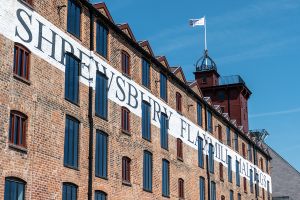
Many brick mills from the start of the Industrial Revolution over two centuries ago can be found across North England, but only a few of those buildings incorporated some sort of architectural or technological innovations. The 1797 Main Mill at Shrewsbury Flaxmill Maltings is one such building.
The construction of the main mill was originally funded by Thomas Benyon, Benjamin Benyon, and John Marshall, who were pioneering the manufacturing of linen from flax. The three men were worried about fires in their mills, which were a common issue at the time and which had severely damaged one of their mills in Leeds. In 1796, the men hired Charles Bage to design the construction of a new mill in Shrewsbury that would be fireproof.
Bage designed a structure that was highly innovative at the time. Instead of using brick walls supported by an internal timber frame, Bage used an internal cast iron frame consisting of three cast iron columns linked together by cast iron beams. The floors of the multiple stories within the mill were made with brick arches built between the beams and held together using iron tie rods. The use of an internal iron frame to support the building’s structure made the building fireproof, and it was highly innovative at the time. Similar internal supporting iron frames would be used a century later to build the first skyscrapers, and such internal frames are now very commonly used in modern building construction.
The Main Mill was used to manufacture linen from when it opened in 1797 to when it closed in 1887. The mill stood empty for a decade until it was converted into a maltings (a place where barley was malted for beer) and reopened in 1897. However, the malting business became uncompetitive several decades later and closed in 1987.
The site again stood vacant for an extended period, but starting in 2014, restoration work began on both the Main Mill and the surrounding buildings. This mill now serves as a museum that describes the history of the site and in particular how a key skyscraper construction technique was developed here when the Main Mill was built centuries ago.
0 comments:
Post a Comment